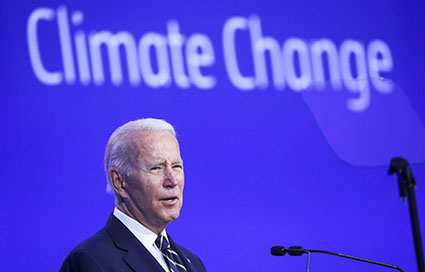by WorldTribune Staff, January 6, 2023
The so-called Inflation Reduction Act included $370 billion over the next decade to help Americans “go green and fight climate change.”
Whoever handles Joe Biden’s Twitter feed stated on Jan. 1: “Starting right now, you can get tax credits to install more energy-efficient appliances for your house. Electric ovens, solar panels, heat pumps: you name it. Save money while fighting climate change.”
 Most Americans who want to save money in “fighting climate change” will have to spend money to do it — in many cases quite a lot of money, an analysis said.
Most Americans who want to save money in “fighting climate change” will have to spend money to do it — in many cases quite a lot of money, an analysis said.
“Many households would need to spend hundreds, if not thousands of dollars to receive a fraction” of what they spend “going greed” back in tax savings, Ramsey Touchberry wrote for The Washington Times on Jan 5.
Team Biden is providing incentives for Americans who give up their gas-powered cars, electrify their appliances, and add rooftop solar panels.
The average 6kW rooftop solar installation runs about $19,000, according to the electrification advocacy group Rewiring America. With 30% of the costs covered via a tax credit, that means the average savings would be $4,700, bringing down the final cost to homeowners to $14,300.
A 30% tax credit can also be obtained on upgrades like energy-efficient heat pumps for heating, cooling and hot water, windows, doors, electric panel upgrades and central air conditioners. But all of those projects will cost homeowners from several hundred to several thousand dollars.
“Those are expensive projects, and households would have to spend multitudes to get tax breaks. In addition to being a homeowner or being able to afford an electric vehicle, the benefits only apply to those who file taxes, which nearly half of Americans are not required to do,” Touchberry noted.
The reductions Americans see in energy costs “will largely benefit those with the means to make expensive home improvements or buy electric vehicles, even as the administration and Democratic lawmakers touted the legislation as a cost-reducing measure for high energy bills,” Touchberry added.
Critics say it is nothing more than a government payout to the wealthy.
“Obviously, this is not necessarily your bread and butter, blue-collar worker who is going to be taking advantage of a lot of these credits,” said Preston Brashers, a senior tax policy analyst at the conservative Heritage Foundation. “For the bottom half or bottom third of Americans, those credits are completely unavailable. And for many others, a lot of people are living paycheck to paycheck. The idea of putting in a lot more money for weatherization or solar panels on your home … is a little bit out of reach for a lot of folks.”
The hypothetical scenarios used by Team Biden to tout benefits for lower- and middle-income individuals “are dubious and unrealistic,” Touchberry wrote.
One example is a fictitious elementary school teacher named Suzy who makes $40,000 per year and is in the market for a new electric vehicle, the average price of which was $65,000 as of November, according to Kelley Blue Book. The cheapest new models start at just under $30,000. The White House said that Suzy could receive up to a $7,500 credit.
However, with strict supply chain requirements that auto manufacturers source and assemble the parts for electric vehicles in North America, the vast majority of new electric vehicles won’t qualify for the credits unless the auto industry makes a major shift. Used electric vehicles under $25,000 qualify for a credit of either $4,000 or 30% of the sale price, whichever is less.
“Working families aren’t salivating for a tax break on $80,000 electric SUVs or expensive, high-tech windows that they do not want and cannot afford,” Sen. John Barrasso of Wyoming, the ranking Republican on the Senate Energy Committee, told The Washington Times. “They’re focused on being able to fill up their gas tanks and grocery carts in the same week. Americans need real relief now.”
Action . . . . Intelligence . . . . Publish
